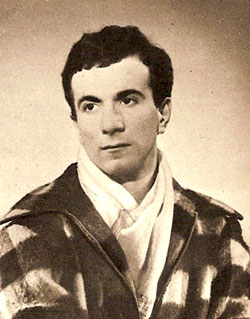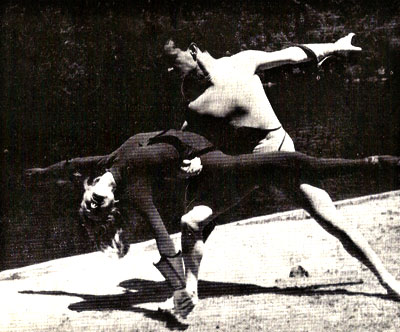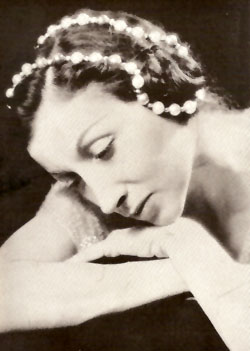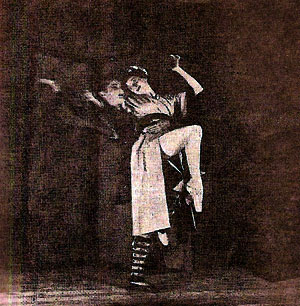| |
Testimonies
& Critics
Les Ballets de Paris de Roland Petit
 |
 |
|
As Irène Lidova wrote on the Dictionnaire du Ballet moderne, Paris, 1957 : "After his rupture with the Ballets des Champs-Elyssées, of which he had been simultaneously its founder and maître de ballet, Roland Petit undertaked the formation of a company which he would direct on his own way. He was lucky enough to find a patronage from the young prince Alessandro Ruspoli, thanks to whom the Ballets de Paris were issued. Their debut was on June 21st, 1948 at the Théâtre Marigny. The stars were Janine Charrat, Colette Marchand, Renée Jeanmaire, Wladimir Skouratoff, Serge Perrault and Gordon Hamilton. For this first season' opening, Margot Fonteyn had accepted to create Les Demoiselles de la Nuit. With the aim of strengthening his program, Roland Petit had summoned well known painters and musicians: André Derain, Leonor Fini, Jean Françaix, Darius Milhaud. Massine came for the occasion for the remake of his Beau Danube and Janine Charrat took at her charge several choregraphies, amongst which La Femme et son ombre and Adame Miroir."
"The "Tout-Paris" made a success of the new company: a brilliant prelude for another summer seasons at the Théâtre Marigny, during which Petit presented his best works: "L'oeuf à la coque", "La Croqueuse de Diamants" and "Carmen".
"For the end of the London season, Petit staged the "Pas d'action" upon Wagner's music, a particularly achieved work, and also presented "Le Combat" by the american choregrapher William Dollar."
As Pierre Michaut wrote on his book "Le Ballet Contemporain", Paris, 1950: "It's in London likewise that William Dollar was invited to create for the company "Le Combat" (Rafaello de Banfield - Marie-Laure <de Noailles> - William Dollar) which argument had been taken from Tasso: Tancredo confronts Clorinda, and is unable to recognise her behind her knight's armor... M.de Banfield is at a time a Dalmatian Baron, a citizen of Trieste, an Italian count, with a London tendency, and a French by adoption. It's Janine Charrat who, exchanging her rôle as a choreographer for that of an interpreter, danced Clorinda. The dance evoked somehow the sharp forms of the insects' combats."
 |
 |
Skouratoff with Madeleine Lafon in a later version of Le combat |
During 1948-49, when Skouratoff was a member at the Ballets de Paris, he danced a long list of works, which we consign in our section His carreer as a classical dancer, both in Paris and London, where the English television presented on January 3rd, 1949, "Adame Miroir" (Sauguet-Charrat) with Roland Petit, Serge Perrault and Wladimir Skouratoff; and the Grand Pas de Deux from Raymonda (Glazounov-Petipa) with Renée Jeanmaire and Skouratoff.
 |
 |
Janine Charrat
(photo: S. Lido)
|
Michaut also says: "Janine Charrat created 'Adame Miroir, a ballet by Jean Genêt (Darius Milhaud-Paul Delvaux-J.Charrat)* with three male rôles only; it's a psychopathic ballet, played over the disturbing frontier of conciousness and delirium; it was also a pathetic evocation of fate...The ballet was danced on a mirror's gallery: the main character stumbled with its reflections as on an insane dream. Jean Genêt, Jean Cocteau's favorite poet, had just suddenly imposed himself over the public attention beyond the initiates circles, and Louis Jouvet had staged his work Les Bonnes, that had been welcomed with curiosity. To dress this male's ballet the sailors costumes had been choosen."
* Théâtre Marigny, May 31st, 1948.
Janine Charrat created afterwards "La Femme et son Ombre", a ballet by Paul Claudel (Tchérepnine-A.Vachon-J.Charrat) : Paul Claudel, during his Embassy at Japan, wrote a little mimo-dramme that had been staged at a theatre in Tokio (1923); transformed on a ballet's libretto, it told a Samurai's story, rather veiled...but we can think a little darkness does become this exoticism. The spectacle, nevertheless, didn't appeared to have attained its definitive form; at last minute, Vachon's décor was discarded and replaced by white screens..."
 |
 |
La femme et son Ombre |
"Que le diable l'emporte", music by Rosenthal, choreography by Petit, costumes and decors by Andre Derain, as it was presented in May 22,1948 with Jeanmaire, Skouratoff and Gordon Hamilton:
Upon this work, Pierre Michaut wrote also in "Le Ballet Contemporain": "Que le Diable l'emporte" ( Let the Devil take her!), ballet by André Derain (Manuel Rosenthal, upon popular XVIII Century' airs - André Derain - R.Petit) gave the impression that its realisation didn't exhausted all the resources and suggestions it could offer. Derain gave the argument, the décor and the costumes for "his" ballet; he designed also the musical motifs for its accompaniment on a recollection of popular songs and contredanses from the Revolution he had retrieved. The action took place on a dance school, on an undetermined time: a conventional "1880", interpreted with a shadow of irony tinted with tenderness. The usual visitors were present: parents, gallants, impresarii, jeaulous husbands...Suddenly, from up above a Devil's ballet falled down. Was it an ambiguous dream of the ballerines, or an unusual irruption of the fantastic amongst this children?... This double univers, real and magic, is truly one of those permanent favourite themes of ballet, after Giselle and Petrouchka, up to La Boutique Fantasque that had been the debut of André Derain on Diaghilew's Ballet."
Les étoiles de la Danse
During 1948-49, Wladimir Skouratoff, Renée Jeanmaire, Serge Perrault and Colette Marchand made a tournée through the United Kingdom and Scotchland, dancing famous pas de deux from their repertoire, such as "La fille mal gardée", "La Péri", "Casse-Noisette" and "Raymonda". The four dancers'company was named "Les Etoiles de la Danse".
|
|